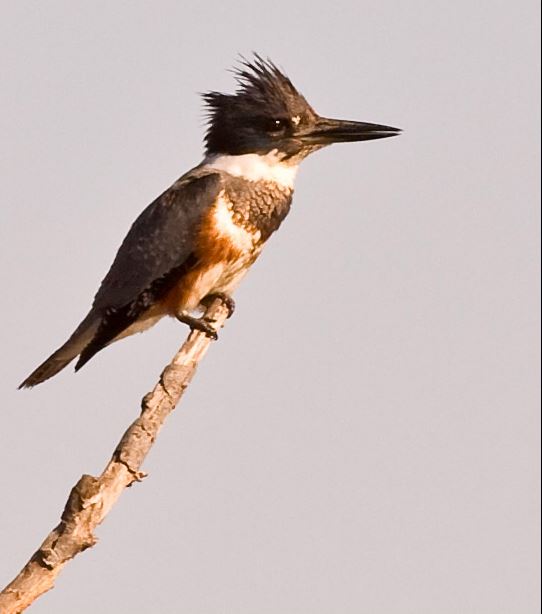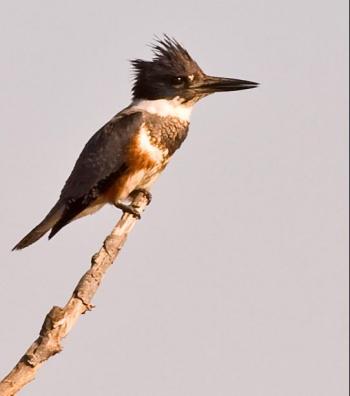In The Presence of Fishing Royalty
The belted kingfisher is a distinctive bird: large head topped with a shaggy crest; thick black bill; comparatively short tail. Now add in the fact that it often sits conspicuously on a wide open perch where even in shadow its silhouette reveals its identity. And rattling call it gives that can be heard from some distance. All of this makes the belted kingfisher a fascinating bird and a favorite of many people, some of whom may know few other bird species.
Here in Maine we have only a single species of kingfisher; across the world there are at least 87 species, with particularly high diversity in Indonesia and Africa. One of my favorites is the shovel-billed kingfisher, a species found only on the island of New Guinea. It uses its massive bill to literally plow through the forest litter in search of earthworms. The kingfisher family also includes the famed laughing kookaburra, named for its raucous call, which includes what sounds like a hearty, wild laugh. Laughing kookaburras eat mostly lizards, snakes, and insects. Many people are surprised to learn that most kingfishers around the world are not as closely tied to a fish diet, as are our belted kingfishers are. Insects, spiders, lizards, snakes, crabs, even small mammals and birds are among the foods eaten by the wide variety of kingfishers.
Our own belted kingfisher is well named as a master of catching fish, although it will take an occasional frog, crayfish, or insect. Belted kingfishers hunt by sitting quietly and watching the water surface for small fish, often in shallow waters. But sometimes they fly out over open water and hover, diving down to try to snatch a fish if it is not swimming too deep.
Here in Maine, although a few kingfishers will attempt to winter along the coast, most migrate south. Some belted kingfishers migrate south as far as northern South America for the winter. On Aruba, Bonaire, and Curacao, the so-called Dutch Caribbean islands off the coast of Venezuela, belted kingfishers are a common sight and sound in mangrove-fringed bays and coves, and around other water bodies from August through May.
Belted kingfishers nest in holes they excavate in dirt, sand, or gravel banks. They use that big bill to peck into the bank, and as they dig deeper, they fling the dirt out behind them with their short little legs. Eventually, through this process they will end up with a long tunnel terminating in an egg-shaped chamber where the female will lay her clutch of 6-7 eggs. After three weeks of incubation by both sexes, the young hatch, and both adults commence a period of intense fishing to satisfy the nutritional needs of their growing family. Interestingly, it is claimed that the young birds in the first weeks of life have a gastric tract that can dissolve and assimilate the calcium of fish skeletons, presumably to add to their own needs for growing bones. Older nestlings and adults do not process bones and must regurgitate the undigested fish bones and scales in small pellets. Young birds stay in the nest for about a month until finally the adults stop feeding them for a day or two and lure them out of the nest with an offering of a fish. Little is known about how long and by what process they learn to hunt and catch fish on their own, but the adults continue to feed them for some time after they leave the nest while they learn to be independent.
Young kingfishers may begin emerging in July in our area. Watch and listen for them, and if you do see some, don’t forget to submit your sighting to the Maine Breeding Bird Atlas as a confirmation of breeding of belted kingfisher!
Jeffrey V. Wells, Ph.D., is a Fellow of the Cornell Lab of Ornithology. Dr. Wells is one of the nation's leading bird experts and conservation biologists and author of “Birder’s Conservation Handbook”. His grandfather, the late John Chase, was a columnist for the Boothbay Register for many years. Allison Childs Wells, formerly of the Cornell Lab of Ornithology, is a senior director at the Natural Resources Council of Maine, a nonprofit membership organization working statewide to protect the nature of Maine. Both are widely published natural history writers and are the authors of the book, “Maine’s Favorite Birds” and the newly published “Birds of Aruba, Bonaire, and Curaçao” from Cornell Press.
Event Date
Address
United States
























